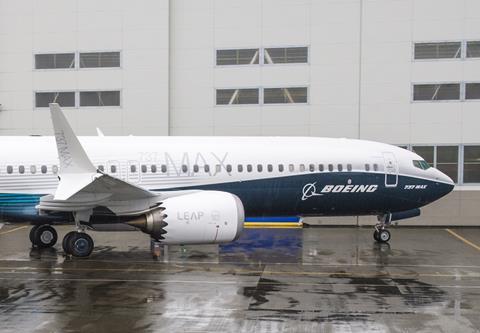The Federal Aviation Administration has taken action to address another issue involving the anti-ice system on Boeing’s 737 Max, after Boeing notified the regulator that a fault could render the system inoperative.
Details of the latest anti-ice system concern come as Boeing works to fix for a separate and unrelated anti-ice problem that generated controversy in recent months.
In a new proposed order, the FAA says the anti-ice system on 205 US-registered 737 Max jets can possibly become inoperative if the standby power system control unit fails.
The regulator has known about the issue for some time. Boeing identified the problem in 2021 during a review of flight deck systems, and notified the FAA about the concern that same year. In November 2022, Boeing issued a bulletin to operators specifying a technical fix.

”Boeing fully supports the proposed directive, which makes mandatory the instructions we shared with operators in November 2022. We continue to provide our customers the support they need to address this issue,” Boeing tells FlightGlobal.
“This is not an immediate safety of flight issue and the fleet can continue operating safely.”
The FAA’s proposed order says “a potential single point of failure exists” in the 737 Max’s standby power system control unit.
Such a failure can result in a “non-latent loss of the entire battery bus and consequent unannunciated loss of control and indication of both engine anti-ice systems”, adds the document, posted to the US government’s regulatory notice database on 14 February.
It adds that the condition, if not addressed, could result in loss of thrust on both engines due to damage from operation in icing conditions without the anti-ice system activated.
The FAA says its action responds to “a Boeing review” of the 737 Max’s standby power system control unit. The agency did not immediately respond to a request for comment.
Boeing’s November 2022 guidance to operators came as an Alert Requirements Bulletin. That document specifies a technical fix involving installing “four diodes and changing wire bundles in the P5 panel”, which is an overhead panel in the cockpit.
The guidance recommends airlines complete the fix within 36 months and the issue has “never been recorded in-service on the 737NG or 737 Max”, Boeing says.
The FAA’s proposed rule applies to both Max 8 and Max 9 models – the only two in-service Max types – and would require that airlines complete the steps in the bulletin. It is accepting comments about its proposal though 1 April.
Boeing has recently been under scrutiny for an unrelated problem involving overheating caused by the 737 Max’s anti-ice system. If used in certain conditions, the anti-ice system can overheat the engine inlet’s inner barrel, possibly causing the barrel to fail.
The FAA in mid-2023 sought to address that problem by requiring airlines instruct pilots not to use the anti-ice system “when not in actual or anticipated icing conditions”.
Boeing is developing a permanent fix to the overheating problem.
Owing to that issue, Boeing last year asked the FAA to temporarily exempt the in-certification 737 Max 7 from some certification rules. An approval would have allowed the FAA to certificate the Max 7 despite the jet not initially meeting regulations as a result of the overheating problem.
That request spurred widespread criticism in January from lawmakers and some pilot unions. At the time, Boeing was under intense scrutiny following the in-flight 5 January failure of a door plug on an Alaska Airlines 737 Max 9. Boeing on 29 January said it withdrew its Max 7 exemption request and will seek instead to certificate the type after developing and implementing the fix.


























